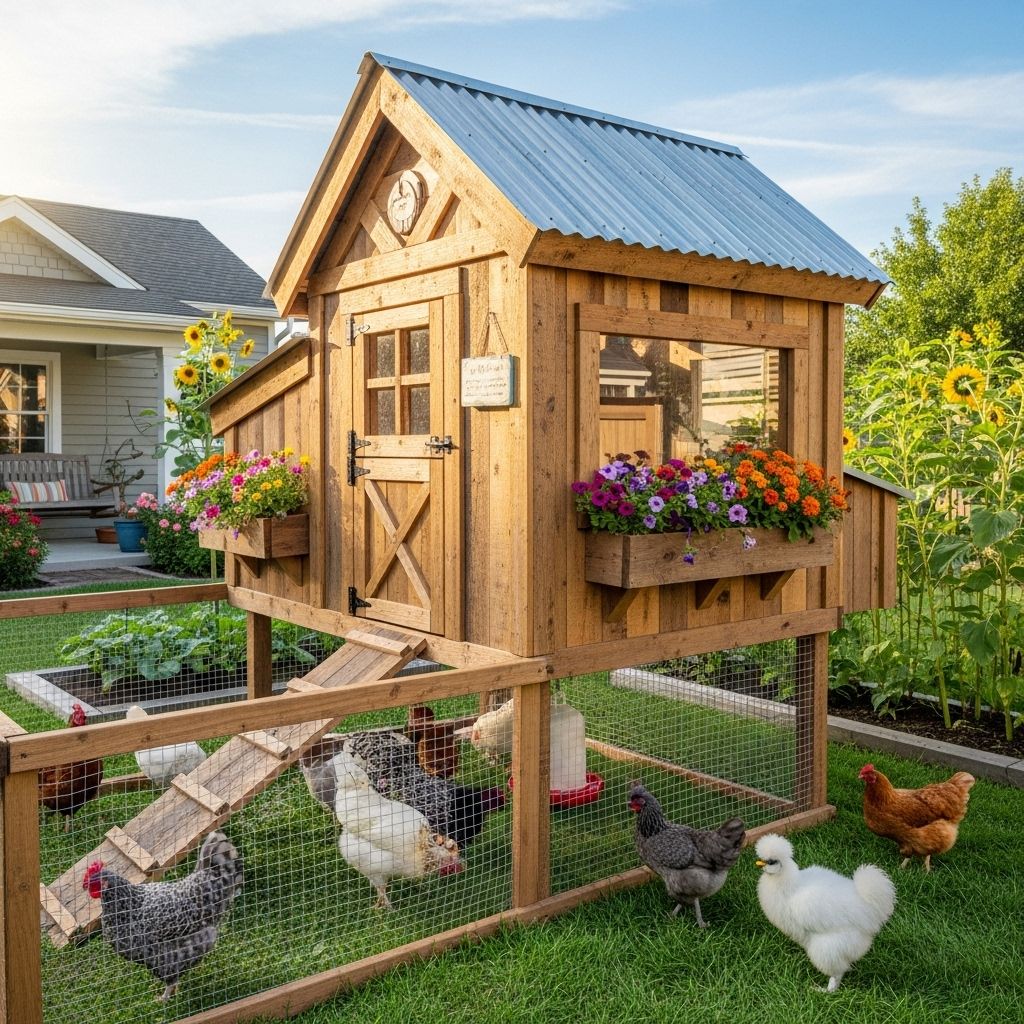DIY Chicken Coop Plans: 38 Inspiring Designs For Your Flock
Transform your backyard into a haven for your feathered friends with these stylish and functional DIY chicken coop designs

Image: HearthJunction Design Team
DIY Chicken Coop Plans & Ideas: Creating the Perfect Home for Your Feathered Friends
Raising backyard chickens has become increasingly popular among homesteaders and urban dwellers alike. Whether you’re looking to enjoy farm-fresh eggs or simply want to add some feathered friends to your family, providing a safe, comfortable, and stylish home for your flock is essential. We’ve gathered 38 DIY chicken coop plans and ideas ranging from simple weekend projects to elaborate dream coops that will inspire you to create the perfect habitat for your chickens.
Choosing the Right Chicken Coop Design
Before diving into building your coop, it’s important to consider several factors that will influence your design choices. Your coop should provide adequate space, protection from predators, proper ventilation, and convenient access for both you and your chickens. Most importantly, it should suit your specific needs and complement your property’s aesthetic.
The general rule of thumb is to allow 2-3 square feet of coop space per chicken and 8-10 square feet of run space per bird. However, if your chickens will have regular access to free-range time, you can reduce the run space slightly. Remember that overcrowding can lead to stress, disease, and reduced egg production.
Pretty & Simple Chicken Coop Plans
Antiques dealer Christi Wilson, known on social media as @thebrownshed, designed a beautiful backyard coop that perfectly complements her farmhouse while providing excellent functionality with easy cleaning features. The 8′-by-12′ structure includes an attached enclosed run of equal size and is cleverly divided into two sections: the front area provides space for feed and supplies, while the back houses the nesting boxes and roost. This spacious walk-in design comfortably accommodates 6 to 9 chickens.
What makes Wilson’s design special is how it balances aesthetics with practicality. The classic farmhouse style with board-and-batten siding and a pitched roof creates a charming visual appeal, while the thoughtful interior layout makes daily chicken keeping tasks efficient and straightforward.
Nestled in the Landscape Coop Plans
For those who value landscape integration, Daniel McCurry’s cottage-style chicken coop offers inspiration. As co-founder and CEO of Father Nature Landscapes, McCurry designed a coop that features a charming metal roof and a large attached run that blends seamlessly into a shady Southern landscape. The attention to detail is evident in the decorative elements like a mounted mailbox and cheerful window box that add character to the structure.
What sets this design apart is how it’s nestled within a lush border of ferns and oakleaf hydrangeas, demonstrating the importance of considering the coop’s surroundings. This approach reminds chicken keepers to think beyond the coop itself and consider how it fits into the overall landscape design of your property. The result is a chicken habitat that enhances rather than detracts from your yard’s beauty.
Large Chicken Coop & Run Plans
If you have a larger flock or simply want to provide more space for your chickens, consider a spacious 20’x9′ walk-in coop and run design that accommodates up to 12 chickens. This style emphasizes functionality with clean lines and practical features that make maintenance easy. The beauty of building your own coop is the ability to customize it with any combination of paint or wood stain that complements your property—you can even match it to your house for a coordinated look.
Easy Coops (easycoops.com) offers various coop plans in different styles and sizes, along with helpful how-to guides covering topics like building permits and cost estimations. Their free plans include step-by-step instructions with illustrations and basic materials lists. For those wanting more detailed guidance, their premium plans (available for just $20) provide complete materials and cutting lists, breakdowns of required tools and fastening elements, additional illustrations and blueprints, plus technical support.
Cape Cod-Inspired Chicken Coop
Photo stylist Heather Bullard and her husband Jim created a stunning Cape Cod-inspired coop that proves functional chicken housing can also be aesthetically pleasing. Despite having a backyard of less than a quarter acre near Los Angeles, they managed to design and build a structure that’s more attractive than many human dwellings—all for approximately $1,600 using stock building materials and hardware from Home Depot.
Their design features a dedicated foyer area that serves dual purposes: it provides a space where the hens can roam when the doors are opened each morning and doubles as a dining area with a galvanized waterer and feeder. Recognizing that chicken waste can be unsightly, they cleverly planted boxwoods in front of the coop to conceal the floor area. The couple also added an attractive brick walkway around the structure, which can be easily hosed off during cleaning.
Cottage Style DIY Chicken Coop
For those seeking a weekend project, a cottage-style coop offers a rewarding building experience with practical features. This design typically includes a door that doubles as a ramp, making it effortless for chickens to enter and exit. Convenience doors built into the nesting boxes allow for easy egg collection from outside the coop—a feature you’ll appreciate during daily gathering.
With dimensions of approximately 4′ x 4′, this intermediate-difficulty project can comfortably house up to 6 chickens. The compact footprint makes it suitable for smaller yards while still providing adequate space for a small flock. The pitched roof adds charm while effectively shedding rain and snow, and proper ventilation ensures healthy air circulation throughout the seasons.
Shed-Row Chicken Coop with Run
A shed-row style coop offers excellent versatility with its straightforward rectangular design and attached run. This configuration provides secure, mesh-enclosed free-range area for daytime activity and elevated sleeping quarters for added protection from predators and ground moisture. The linear layout makes it easy to expand by adding additional sections if your flock grows over time.
This design is particularly well-suited for placement along property lines or fence rows, maximizing yard space while providing chickens with a comfortable living environment. The shed-row style typically features easy access doors for maintenance and cleaning, along with conveniently positioned nesting boxes for egg collection.
Essential Features for Any Chicken Coop
Regardless of which design you choose, certain elements are crucial for a successful chicken coop:
- Proper ventilation: Chickens produce significant moisture and ammonia through their droppings, making good airflow essential for preventing respiratory issues.
- Predator protection: Secure hardware cloth (not chicken wire) on all openings, predator-proof latches, and raised floors help keep chickens safe.
- Roosts: Provide 8-12 inches of roosting space per bird with roosts positioned higher than nesting boxes.
- Nesting boxes: Include one box for every 3-4 hens, sized approximately 12″x12″x12″.
- Easy cleaning access: Design your coop with maintenance in mind—removable dropping boards, accessible corners, and washable surfaces make cleaning much simpler.
- Protection from elements: Ensure the coop provides shade in summer and shelter from wind, rain, and snow in harsher seasons.
Materials Considerations for DIY Coops
When selecting materials for your chicken coop, durability and safety should be top priorities. Pressure-treated lumber is commonly used for the frame and floor since it resists moisture and insects, but avoid using it where chickens might peck at it directly. Cedar and redwood naturally resist decay and insects without chemical treatments, making them excellent (though more expensive) choices.
For roofing, options include asphalt shingles, metal roofing, or corrugated plastic—each with different advantages regarding cost, longevity, and installation complexity. Flooring materials should be easy to clean and resistant to moisture; many builders use vinyl flooring, linoleum, or sealed plywood for the interior floor surface.
Frequently Asked Questions About Chicken Coops
Q: How big should my chicken coop be?
A: The general guideline is 2-3 square feet of interior coop space per chicken and 8-10 square feet of run space per bird. Bantam breeds require less space, while larger breeds need more. Always err on the side of providing more space rather than less.
Q: Do I need a permit to build a chicken coop?
A: Permit requirements vary widely by location. Check with your local zoning department and homeowners association (if applicable) before building. Some areas restrict the number of chickens you can keep or have specific requirements for coop placement relative to property lines.
Q: How do I protect my coop from predators?
A: Use 1/4″ or 1/2″ hardware cloth (not chicken wire) on all openings, bury it at least 12″ around the perimeter of the run, install predator-proof latches on doors, use solid flooring in the coop, and consider automatic door closers that secure the coop at dusk.
Q: What’s the best way to insulate a chicken coop?
A: Focus on eliminating drafts while maintaining ventilation. Rigid foam insulation can be used in walls and ceiling but should be covered so chickens can’t peck at it. Deep bedding methods like the deep litter system provide floor insulation during winter months.
Q: How often should I clean my chicken coop?
A: Perform quick daily maintenance by removing obvious soiled bedding and collecting eggs. Deep clean the coop fully every 2-6 months depending on flock size, coop size, and season. More frequent cleaning is necessary in smaller coops or with larger flocks.
With these plans and considerations in mind, you’re well-equipped to create a functional, beautiful home for your backyard flock. Remember that the perfect chicken coop balances the needs of your chickens with your aesthetic preferences and maintenance capabilities. Happy building!
References
- https://www.countryliving.com/diy-crafts/g2452/diy-chicken-coops/
- https://www.countryliving.com/gardening/garden-ideas/how-to/g1147/ultimate-chicken-coop/
- https://www.youtube.com/watch?v=UPs5wg_xwHg
- https://easycoops.com/wp-content/uploads/2022/FreePlans/12x8_Chicken_Coop_Plan_Free.pdf
- https://easycoops.com
Read full bio of Srija Burman











